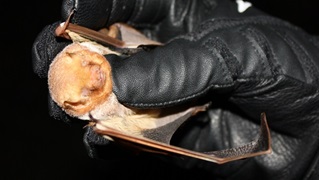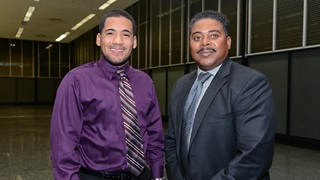Providing raptor rapture and rehabilitation for 25 years
Illinois Raptor Center supports birds of prey with education, research and care
Ruby may not have the proverbial eagle eyes anymore—old age has caused at least one detached retina—but at 25 years old, she still has a presence.
“Ruby is very large, and very much in charge,” says Jacques Nuzzo, program director at the Illinois Raptor Center. “She’s independent and stubborn . . . everyone here just loves her independent spirit.”
Staff at the Illinois Raptor Center have seen plenty of that spirit since 1991, when the Decatur-based facility was established. While Ruby has a permanent home, thousands of other sick, injured or orphaned birds of prey have been taken in, cared for and released back into the wild by IRC volunteers over the past quarter-century.
With a staff of 18, the IRC handles anywhere from 250 to 300 hawks, falcons, ospreys, kestrels, owls, and other raptors each year, and has seen every single bird of prey found in the Land of Lincoln, except for the Mississippi kite.
It’s essential work—because, as Nuzzo notes, birds of prey are barometers of the relative health of an ecosystem.
“They’re at the top of the food chain, so there has to be an elaborate, intricate web of life in existence—fish, insects, plankton, a healthy body of water—for them to nest and hunt in an area,” he says. “If you want to learn a lot about the health of an ecosystem, you tend to look at the predatory species.”
That’s why the IRC has evolved beyond care and rehabilitation, through its well-equipped animal hospital, to become the largest and most innovative facility of its kind in Illinois. Serving more than 20 counties, the IRC is actively involved in:
- Vital research into endangered species and bird-borne diseases, alongside government agencies, academia and non-profit societies;
- A unique nest rescue program called Nest-cue, returning chicks and restoring nests; and
- A robust educational program, involving the public, schools and camps, with help from the IRC’s stable of 37 on-site surrogate birds, including Ruby.
Now, the IRC is working an ambitious project called Super Flight, the largest flight facility for eagles in the U.S. Midwest. Large raptors in the Super Flight enclosure—measuring nearly 400 feet long, 16 feet wide and 17 feet high—will be able to fully recover, rebuilding muscle and developing endurance, before being released back into the wild.
Enbridge is committed to enhancing quality of life in the communities near our projects and operations—including the Southern Access Extension pipeline, whose right-of-way travels past the 25-acre IRC facility—and we invest regularly in programs that promote environmental stewardship, conservation and environmental education.
We recently made a $5,000 donation to the IRC to help the Super Flight project take wing.
“We needed donations to help us complete our Super Flight project, and Enbridge stepped forward,” says IRC executive director Jane Seitz. “Enbridge has demonstrated its respect and concern for our native birds of prey by helping with this significant project.”
(TOP PHOTO: Illinois Raptor Center program director Jacques Nuzzo with a juvenile bald eagle.)










